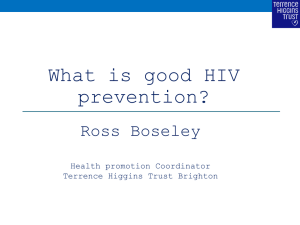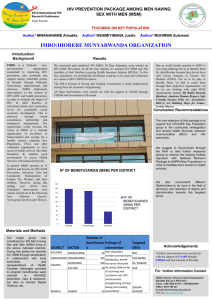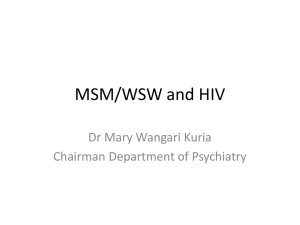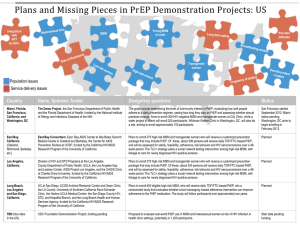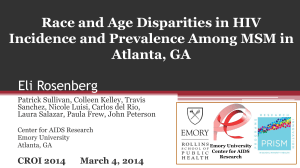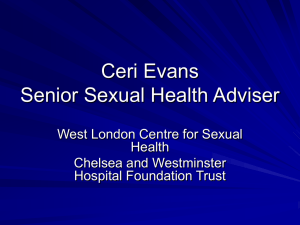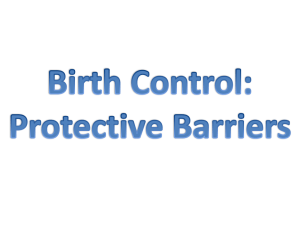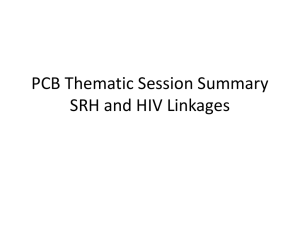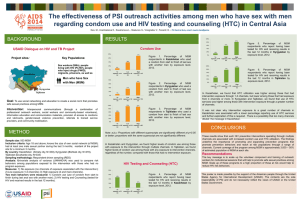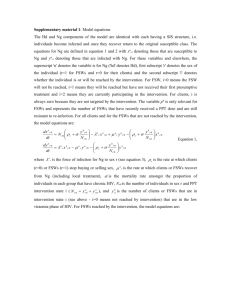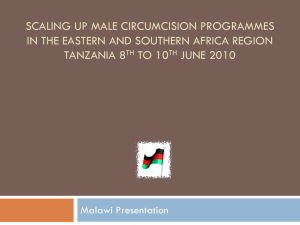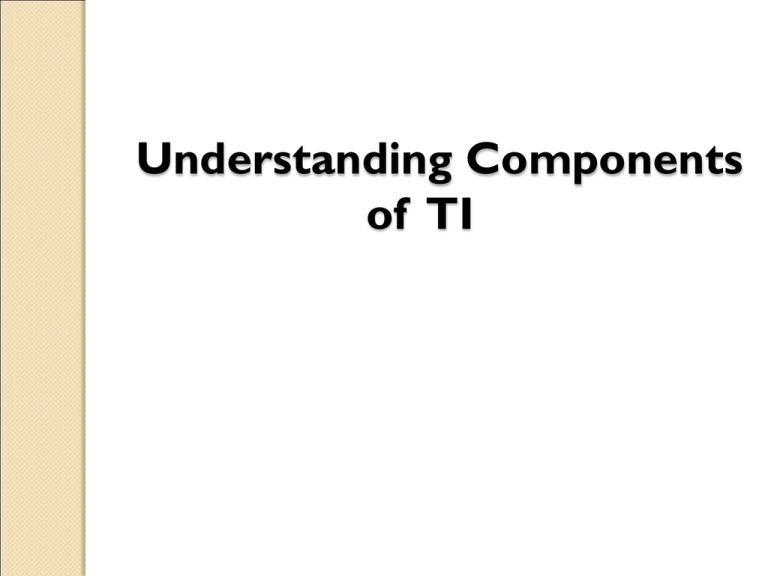
Understanding Components
of TI
Why Targeted Intervention?
Any epidemic has following four stages-
Wave I
Wave II
Wave III
Wave IV
Sex Workers/
IDUs
Male STD Pts,
Mobile Groups
Spouses & Children
of Male STD Pts
Adolescents
Spread of
HIV, STD
patients
Trauma, illness
& death, STD &
TB patients
Survivors, AIDS
Pts, ANCs,
Pediatric AIDS
Long-term
socio-economic
impact, Orphans
HIV infection among different population groups
15
10
5
0
ANC
STD
FSW
IDU
MSM
2003
0.87
5.61
10.3
13.3
12.1
2004
0.89
5.55
9.43
11.2
7.5
2005
0.88
5.66
8.44
10.16
8.74
2006
0.68
4.56
9.4
10.6
11.6
2003
2004
2005
2006
In India, HIV/AIDS concentrates upon High Risk Groups (FSW, MSM
and IDU) and Bridge Population (Truckers & Migrants).
The need, therefore is to actively control HIV/AIDS among these
groups.
The importance of working with core
groups – FSWs
HIV Positive contacts per year
Population
1,000
FSWs
1,000 clients
(e.g. migrants,
truckers)
25% infected, 400 partners per year
100,000
2% infected, 12 partners per year
240
The importance of working with core
groups – MSM
Client or
other
category
MSM –
not focus
of TI
High risk
MSM –
focus of
TI
•
•
•
Truckers
Taxi/auto drivers
Single male migrants
•
Hijras
•
Male
sex
workers
•
Kothis
Anal
receptors
•
Panthis
•
•
Regular
partners
of kothis
Double
deckers
Anal receptors
& penetrators
Anal
penetrators
Locus of
intervention –
typically
‘cruising sites’
or hotspots
The importance of working with core
groups – IDUs
of FSWs
Wives and
girlfriends of
clients
Clients
of FSWs
Wives and girlfriends of
Substance users
Female Sex
Workers
“Feminization”
of the epidemic
IDU
Husbands and
boyfriends of FSWs
RISK RINGS
HIV
Substance Users
The importance of working with core
groups – Migrants/Truckers
Targeted
Intervention
Male Clients
FSWs
Male Migrants
Lessons from NACP-II
Dilution in TI; more focus on Core Groups
Programmatic link between TI and
Continuum of Care
Need to strengthen Supportive
Supervision; support to SACS / NGO
Strategic shift from Support to
Empowerment
Main focus of TI
Prevention
Reversal of the progression of the infection
and Reduction in the overall level of
prevalence
Evidence-based approach
Guiding principles of TI
In any health condition, with any population, the uptake of prevention
service depends on outreach.
This holds more true in the case of marginalized populations such as
sex workers, MSM, and IDUs.
The core of FSW/MSM/IDU HIV prevention efforts is therefore about
outreach and the provision of dedicated services, which can be
accessed by these marginalized groups.
Targeted Interventions Under NACP-III
1.
More focused approach
Core Groups
Bridge Population
FSWs
IDUs
MSM
Truckers
Migrant Workers
2. Specific package of services for HRGs
Components of
Targeted
Intervention
Behaviour
Change
Communication
Management of Sexually Condom
Promotion
Transmitted Infections
Community
Mobilization
3. Emphasis on CBO-led Interventions
Enabling
Environment
Referrals
&
Linkages
Components of TI
Management
of STIs
Behaviour
Change
Communication
Condom
Promotion
HRGs
Enabling
Environment
Referrals &
Linkages
Community
Mobilization
Condom Promotion
Every person should have access to
condoms when he/she needs it
Primary Strategy: Free supply of condoms
to HRGs through TI NGOs/CBOs
Secondary Strategy: promoting social
marketing of condoms through Social
Marketing Organizations
Community Mobilization
Community members get to participate in
collective decision-making
Formation of various committees like DIC
Management Committee and Clinic
Committee empowers the community
It creates community norms for service
uptake and safe sexual behaviours
Referrals & Linkages
Linkages to STI and health services with
strong referral and follow-up
Promotion/distribution of commodities
including free condoms, lubricants,
needles/syringes
Linkages to other health services (e.g. for
TB) and voluntary counselling and testing
centres (VCTCs)
Provision of safe spaces (DICs)
Management of STIs
STI services: an opportunity for prevention education to
the individual as well as to his/her partner
Planning for STI services done with the HRGs
Clinicians should have an attitude of respect towards the
community.
Availability of services should be as per the needs of the
community (for e.g. late-night access)
Accessibility of services at optimal locations (i.e. not too
far from the major sex work sites)
Enabling Environment
To enable HRGs to negotiate safer sex, TIs must address
several vulnerabilities
Vulnerability within the sex circuit includes aspects such
as violence, and exploitation by clients
Broader socio-economic vulnerabilities include factors
such as poverty and illiteracy
Reduction of vulnerabilities entails creating a crisis
response system
It also calls for advocacy with policy makers, law
enforcers and opinion leaders
Behaviour Change Communication
It is vital to change the community’s behaviour to
ensure that they indulge in safer sex
This involves creating awareness about the
importance of using condoms, services available for
STIs and the importance of regular screening
It also means creating a demand for these services
TIs need to encourage analytical thinking and
problem-solving among HRGs so as to help them
overcome their barriers to HIV/STI risk reduction
Remember!
HIV is no longer a killer disease
It is a manageable disease, just like Diabetes and
Blood pressure
But for this it is necessary to
o regularly check one’s status at VCTCs
o use condoms during every sexual act
o If HIV+, regularly take the medicines & live a
healthy life
Hence TIs should develop their linkages with
government departments, VCTCs, Hospitals, ART
centers, CCCs and such like
Conclusion
The focus of the TIs should be that
o all key populations are being met regularly
o all key populations are able to access condoms
and use it correctly and consistently
o all are regularly screened for STI and HIV
o all in need of care and support are able to access
the same
o the environment around sex work is safe
With sincere efforts, the HIV epidemic can be
reversed much before 2015, as desired by the
Millennium Development Goal (MDG)

